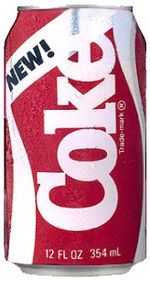Just after World War II, the market share for The Coca-Cola Company's flagship beverage was 60%. By 1983, it had declined to under 24%, largely because of competition from Pepsi-Cola. Pepsi had begun to outsell Coke in supermarkets; Coke maintained its edge only through soda vending machines and fast food restaurants. Market analysts believed baby boomers were more likely to purchase diet drinks as they aged and remained health- and weight-conscious. Therefore, any future growth in the full-calorie segment had to come from younger drinkers, who at that time favored Pepsi and its sweetness by even more overwhelming margins than the market as a whole. When Roberto Goizueta took over as CEO in 1980, he pointedly told employees there would be no sacred cows in how the company did its business, including how it formulated its drinks.
New Coke was the reformulation of
Coca-Cola introduced April 23, 1985 by The Coca-Cola Company to replace the original formula of its flagship soft drink, Coca-Cola (also called
Coke). New Coke originally had no separate name of its own, but was simply known as "the new taste of Coca-Cola" until 1992 when it was renamed
Coca-Cola II.
It proved to be quite the firestorm which ended with the return of the original formula, now called
Coca-Cola classic, a few months later. The return of original formula
Coca-Cola on July 10, 1985, put the cap on 79 days that revolutionized the soft-drink industry, transformed The
Coca-Cola Company and stands today as testimony to the power of taking intelligent risks, even when they don't quite work as intended.


No comments:
Post a Comment